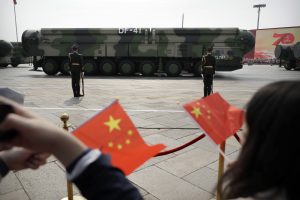In July 2021, the United States launched its Nuclear Posture Review, aimed at reportedly reducing the importance of nuclear weapons. Amid this process, Washington’s allies worry about possible evolutions in fundamental principles of nuclear deterrence. For that reason, in their joint statement published on October 29, the United States and France reasserted the importance of nuclear capability to “preserve peace, prevent coercion, deter aggression.”
In September, pushing the debate already existing in the United States, Beijing’s former U.N. representative for arms control, Sha Zukang, mentioned that China might abandon its long-term no first use doctrine, unless Washington decides to declare its own no first use policy.
Recently the world has been focusing on the intimidating expeditions of China’s People’s Liberation Army Air Force (PLAAF), when over several days in October more than 150 planes entered Taiwan’s Air Defense Identification Zone (ADIZ). These maneuvers, however, took place more than 100 nautical miles away from Taiwanese shores, in the southwest corner of Taiwan’s ADIZ. This might very well be a Chinese opera, where firecrackers and martial posturing are there to hide the real action: the development of a more robust nuclear power.
China’s conventional capabilities, including those of its navy, are indeed increasing rapidly and impressively. The core of China’s military strategy, however, relies on its nuclear and delivery capabilities. China has apparently started to build more than 250 intercontinental ballistic missile silos at three sites in Gansu and Inner Mongolia, a huge jump from the initial 20.
China has always refused to be part of arms control negotiations, arguing that its arsenal is far smaller than those of Russia and the United States. Depending on sources, China’s nuclear arsenal is limited to approximately 300 warheads, on par with the French arsenal.
The rapid construction of new silos, however, may indicate a massive increase in China’s nuclear warheads. The figure could double before the end of 2040, with the accelerated deployment of new multiple-warhead solid fuel ICBMs such as the DF 41.
Despite its official denials, in August China may well have tested a nuclear-capable hypersonic glide vehicle, the DF 17. This type of vehicle is not as rapid as a ballistic missile; however, it can change trajectory to avoid missile defense mechanisms. Launched from an orbital trajectory, it could also escape advanced warning systems. In the 1970s, the Soviet Union deployed a similar type of system and then abandoned it in favor of submarine-launched ballistic missiles. In a reverse move, confronted with the limitations of its SLBM program including in terms of command and control, China might be tempted to rely on a type of less detectable delivery vehicle.
These moves may also signal a change in China’s nuclear doctrine. With more warheads, along with more sophisticated and less vulnerable delivery systems, China may be on the verge of acquiring a first-strike capability, a departure from its traditional posture of minimum deterrence.
Anxious not to suffer the fate of the Soviet Union, China has always refused to be dragged into an unwinnable arms race with the United States. A guaranteed second-strike nuclear capability is enough to achieve China’s objectives. But that objective is threatened by U.S. conventional precision strike capabilities, superiority in next-generation ISR, and ballistic missile defense developments at the regional level. This last aspect threatens the deterrent effect of China’s nuclear-capable middle-range ballistic missiles, which can target U.S. bases in Asia as well as the United States’ closest allies in the region.
China’s nuclear doctrine and objectives have not changed fundamentally. Credible nuclear capabilities have always been part of China’s strategy of deterrence and anti-access/area denial (A2/AD) against the United States. By reinforcing the credibility and certainty of its second-strike capability, China expects to deter the United States from intervening in a regional conflict, for example, Taiwan’s “reunification” by force or grey zone tactics. China wants to assert its capacity in order to make use of a set of pressure tactics, using public opinion in the United States as well as among U.S. allies such as Japan. In the event of a conflict in the Taiwan Strait, Japan would be very nearly on the frontline. However, Japan is also extremely risk-averse and vulnerable to threats of missile strikes from China.
To win in a regional conflict, China must maintain pressure to dissuade the United States from intervention by using the threat of escalation, to make the idea of intervention impossible to fathom. China is playing on reticence among the U.S. public to engage in asymmetric wars, where one side projects a high level of will when the other seems to be less involved. China is betting on a “Munich moment,” relying on its nuclear capabilities to keep any future conflict local or even under the threshold of war, thereby winning without fighting.
The acceleration of silo construction and the testing of new “game-changing” arms are all part of a nuclear signaling game in times of peace that serve to demonstrate China’s determination and impress the adversary. By increasing these capacities, China is testing the sole guarantor of strategic stability in Asia, the United States, and the will of the U.S. to intervene.
In this context, U.S. deterrence can only be effective without conditions or caveats such as “no first use” or “sole purpose.” Otherwise, China’s leadership might get a false sense of security and be tempted to launch a conventional war to take the initiative. For a leader like Xi Jinping, eager to achieve the “great rejuvenation of the Chinese nation,” a change in U.S. nuclear policy might be just the push needed for action – most certainly based on miscalculation, but with dramatic consequences.

































